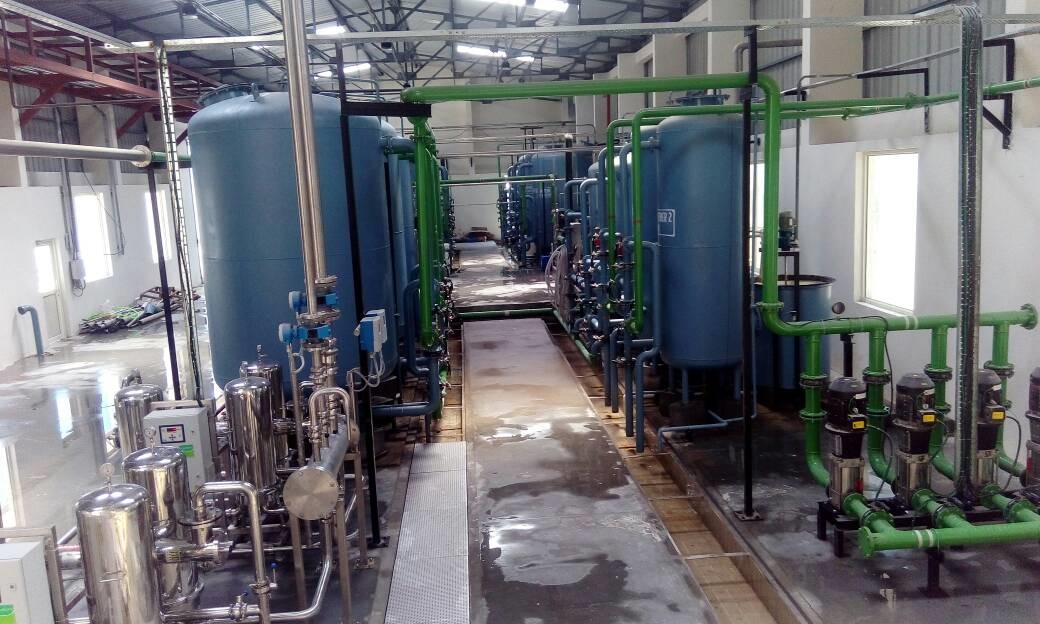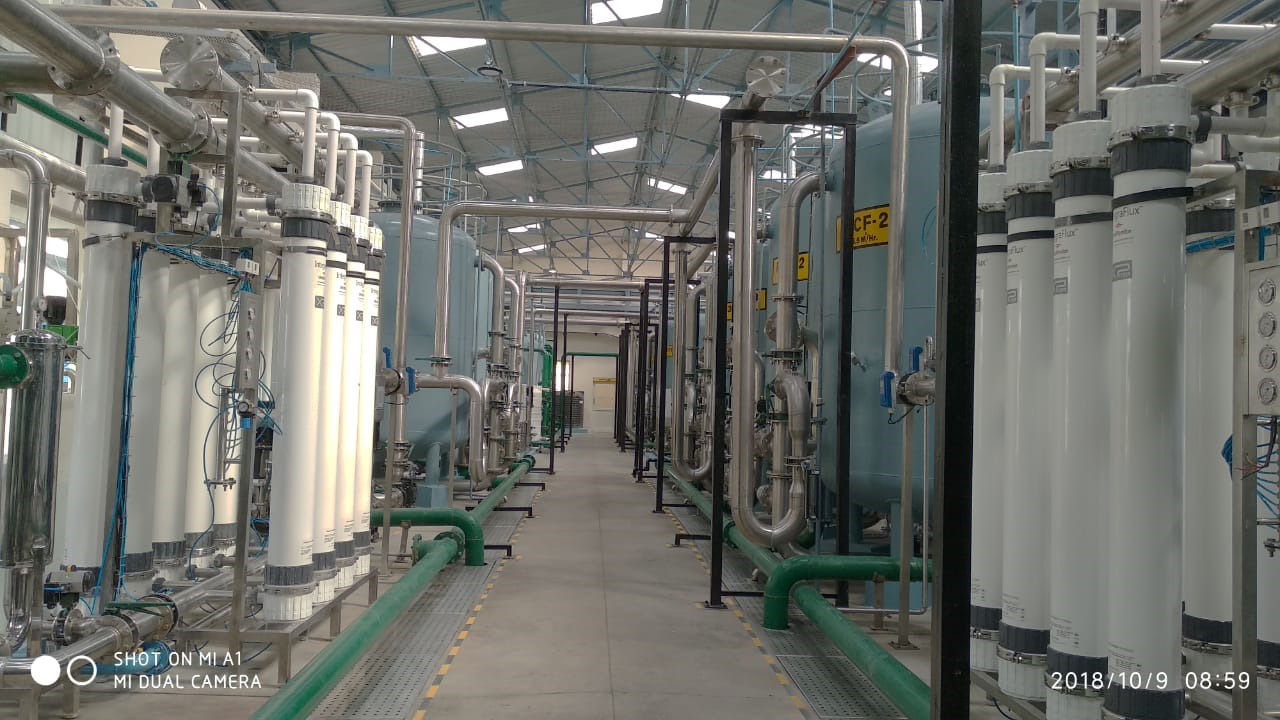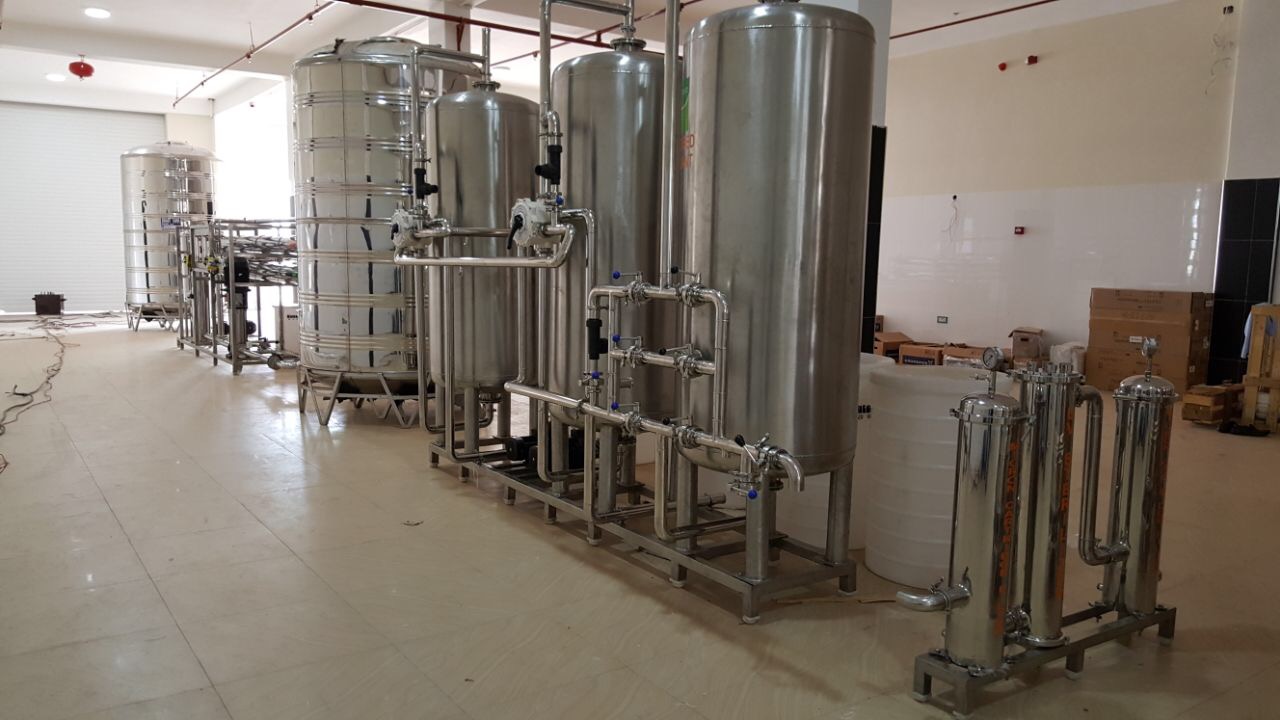IRON REMOVAL FILTER
Iron removal filter is processed catalytic filtration unit where the raw water passes through the layer of compressed air, processed catalyst & quartz filter media respectively. The dissolved ferrous iron salts are converted into insoluble ferric salt and precipitated over the filter bed and then the iron free filtered water comes out.
Greensand is the name commonly applied to a sandy rock or sediment containing a high percentage of the mineral glauconite. Glauconite ((K, Na) (Fe3+, Al, Mg)2(Si, Al)4O10 (OH)2) is a greenish-black to blue-green mineral which forms in shallow marine sedimentary deposits. Early in the 1900’s, glauconite was recognized as having chemical exchange properties in water solutions, which led to its use as a water softener media. With the development of higher efficiency polymer-based ion exchange resins, its use for this essentially ceased in the 1970’s. Glauconite, coated with manganese dioxide, was found to be an excellent greensand filtration media for catalysing the oxidation of soluble iron and manganese and the gas hydrogen sulphide.
Once oxidized to the form of tiny particles, manganese greensand serves as an effective filtration media to filter the particles. Recently a second generation of greensand has been developed which uses a silica sand core instead of glauconite, which allows it to better withstand operating conditions in waters that are low in silica, total dissolved solids and hardness as well as higher operating temperatures and higher differential pressures.
Iron, Manganese and Hydrogen Sulphide Water Contaminants
Iron and manganese are naturally occurring minerals comprising about 5% and 0.1% of the earth’s crust, respectively. If present as part of the geological strata in contact with underground aquifers, both will dissolve in water, particularly when the water has a depressed pH. Both have USEPA secondary maximum contaminant levels for potable water based on aesthetics (i.e., they are regulated because of staining, taste and discoloration of beverages such as tea rather than health concerns).
Iron will cause staining at concentrations ≥ 0.3 parts per million (ppm) while manganese begins staining at ≥ 0.05 ppm. These thresholds are also the current MCL’s for each. Both can be present in the soluble or oxidized form as the water is pumped from the well. If the water appears clear, but turns red upon exposure to air (oxygen), the majority of the iron is dissolved (called soluble or “clear water” iron which is present as Fe+2) while oxidized or “red water iron” is present as tiny particles of Fe+3.
Manganese behaves similarly except it has a purplish-black appearance in the oxidized form. If 100% of either metal is oxidized in the aquifer, filtration alone, without any chemical addition, will remove the contaminant. There is another form of iron called “heme iron” where it is bound with organic molecules (e.g., tannins). Removal of heme iron typically requires more severe chemical pre-treatment to break the iron-organic bond before filtration. Hydrogen sulphide, an odorous gas that smells like rotten eggs, is dissolved in the water present in some aquifers.
Hydrogen sulphide dissipates from water quickly once it is pumped to the surface and exposed to air. In fact, particularly in climates where freezing is not a problem, aeration is a relatively inexpensive way to treat high flows.
Chemical Treatment and Filtration
Filter Design: Greensand filters are typically designed to flow at 3-5 gpm per square foot of filter surface area and need a minimum of 12 gpm per square foot for backwash. Backwash should be initiated manually or by pressure differential switch when the differential pressure across the filter increases by 12 psi. Excessive delta P can damage the media.
Chemical Pre-treatment
Filtration with manganese greensand often requires pre-treatment with an oxidizing agent. On small commercial or residential systems, this may be accomplished by oxygen in the air using a small air pump and a contact tank upstream of the greensand filter. In large flows such as with industrial water filtration, it is typically accomplished with chlorine and / or potassium permanganate, a strong oxidizer. Because the oxidation reaction required to convert the soluble material into solid particles, followed by successful filtration must be accomplished in 1-2 minutes of filter residence time, the water chemistry must be conducive to rapid reaction kinetics. Technical literature typically recommends pH in the 6.2 to 6.5 range. Our experience with waters in the SE US demonstrates pH 6.8 to be optimal. Alkalinity must be ≥ 120 ppm. These parameters can be adjusted by metering a dilute caustic and / or a soda ash solution into the water upstream of the filter to adjust pH and alkalinity, respectively. For iron alone, chlorine fed at a concentration of 1.0 to 1.2 times the iron should be adequate to oxidize the iron and “regenerate” the manganese greensand. Since excess chlorine is not deleterious to greensand filtration, it is possible to feed enough to provide adequate free chlorine residual in the filtered water sufficient for introducing into the clear well and pumping to service.For water containing manganese and iron, feed chlorine followed by potassium permanganate upstream of the greensand filters. Start with a chlorine dose calculated as 1.0 times the iron and 2.0 times the manganese concentration and introduce a small feed of permanganate. Collect minimum one-litre samples in a glass container (a one-liter Erlenmeyer flask is ideal) just upstream of the greensand filters and observe the colour in good light. Chlorine alone should cause a yellowish tinge. When a pink tinge is first observed, the permanganate dose should be about right. If the colour is distinctly pink, the potassium feed is too high.
Hydrogen sulphide pre-treatment is similar to that for manganese. Start with a chlorine dose about 2.0 times the hydrogen sulphide and adjust permanganate to achieve the same colour.
FRP IRON REMOVAL FILTER

Aguapuro Series FRP Iron removal Filters are available from 8” up to 63” diameter sizes and from 0.5 to 500 M3/hr Flow rate when operated on 4.8 - 30 M3/hr/M2 velocity. Higher Flow Rates are designed on requests. Being constructed from vessel of FRP and Piping of UPVC / CPVC / SS 316, it gives complete corrosion free operation.
MILD STEEL IRON REMOVAL FILTERS

Aguapuro series MILD Steel Iron removal Filters are available from 300 mm to 4500 mm diameter sizes and from 1 m3 to 500 M3/hr Flow rate when operated at 4.8 to 30 M3/hr/M2 velocity. These Filters are fabricated using IS 2062 Mild Steel or Carbon Steel Plates & IS 1239 Pipes are used to fabricate Filters and its piping. Filters are internally Epoxy coated or Rubber Lined to have corrosion free operation.
STAINLESS STEEL IRON REMOVAL FILTERS

Aguapuro Series Stainless Steel 316 Iron removal Filters are available from 300 mm up to 4500 diameter sizes and from 0.5 to 500 M3/hr Flow rate when operated on 4.8 - 30 M3/hr/M2 velocity. Higher Flow Rates are designed on requests. Being constructed from SS 304 or 316 material with or without Internal Epoxy Lining vessel and SS 316 Pipe work and valves, it gives complete corrosion free operation.

